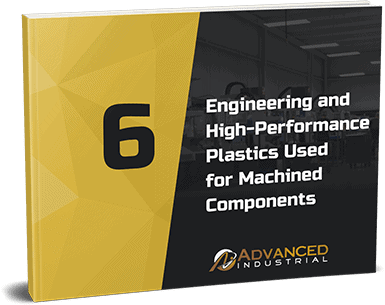PEEK Machined Components
Polyether ether ketone (PEEK) is a thermoplastic that has gained recognition in engineering and manufacturing due to its exceptional characteristics. It is ideal for producing machined components, from its excellent thermal and chemical resistance to its biocompatibility and electrical properties. Moreover, PEEK is increasingly used in the aerospace, automotive, and medical sectors.
Advanced Industrial is a premier distributor and fabricator of high-performance plastic materials and products! We are equipped with state-of-the-art facilities and skilled technicians, allowing us to take on projects of any size and complexity. Whether it is a prototype or a large-scale production run, we are committed to delivering exceptional results on time and within budget.
What Is PEEK Machining?
PEEK is a high-performance material with excellent mechanical, thermal, and chemical resistance. As a result, it is an ideal choice for creating components necessitating durability, stability, and strength. However, machining PEEK can be challenging due to its high melting point and abrasiveness, which requires high precision and expertise.
The machining process involves using specialized equipment and tools to shape and form the material into the desired configuration. This includes designing the component using CAD software and selecting the appropriate method based on the product specifications. Once these steps are complete, the machine must be programmed to execute the operations accurately.
Applications of PEEK Machined Components
PEEK machined components have a broad range of applications due to their exceptional properties. Here are some of the most common applications of these components in diverse industries:
Aerospace
The aerospace industry utilizes PEEK components because they offer an impressive strength-to-weight ratio and exceptional resistance to radiation and chemicals. They can also endure extreme temperatures. Bearings, seals, and structural parts are all examples of PEEK products utilized in aerospace.
Automotive
PEEK components are commonly used in the automotive industry due to their remarkable ability to resist heat, chemicals, and wear. Automotive applications of PEEK components include engine parts, fuel system parts, and electrical connectors.
Electronics
PEEK has a high dielectric strength, which means it can withstand high voltages without breaking down or losing its insulating properties. It also has a low dissipation factor for an efficient transfer of electrical energy without losing any power as heat. This makes it ideal for manufacturing connectors, switches, and insulators.
Industrial
The material’s superior chemical resistance, high-temperature stability, and excellent wear resistance make it a practical choice for industrial manufacturers. As a result, it is frequently used in pumps, valves, seals, and other parts and products constantly exposed to aggressive chemicals or high temperatures.
Material Availability
At Advanced Industrial, we understand the importance of having access to high-quality materials for specific projects. That’s why we are committed to offering a comprehensive range of materials and services to meet the needs of our customers.
- Compression-molded rings and disks
- Compression-molded rod
- Compression-molded sheet
- Compression-molded tubing
- Custom bearings and wear components
- Custom compounds in small batches
- Custom gears
- Extruded film
- Extruded rod
- Extruded sheet
- Extruded tubing (tight tolerance)
- Injection molded tubing
- Tight tolerance CNC machined components
We also offer PEEK in the following types and configurations:
- PEEK 450G (Virgin-unfilled)
- PEEK GF (Glass-filled)
- PEEK CA (Carbon-filled)
- PEEK PTFE (Teflon-filled)
- PEEK 5025 (Bearing grade)
- PEEK 5035 (Bearing grade)
- PEEK HPV (10/10/10 BG)
- PEEK 5032 (Aramid fiber-filled)
Advanced Industrial: The Leading Provider of High-Performance Plastic Machined Components
Advanced Industrial has extensive experience machining challenging parts from various materials, including PEEK, PPS, Acetal, Ultem, PTFE, Ertalyte PET, and nylon! Our team is committed to working with you to understand your needs and provide the most cost-effective and efficient solutions. We also have the necessary knowledge and skills to produce components to exact specifications.
Contact us today to learn more about our capabilities!


